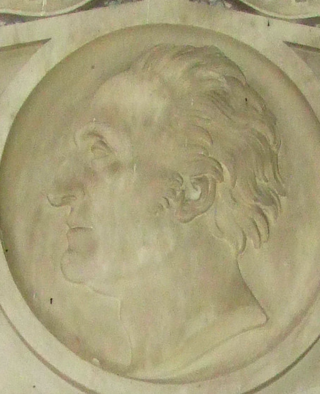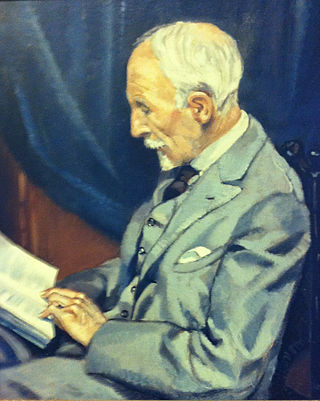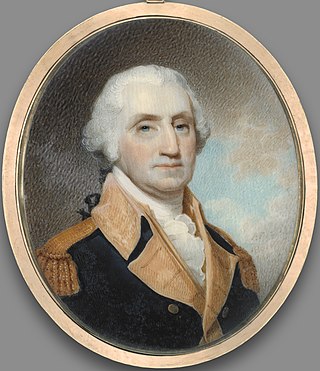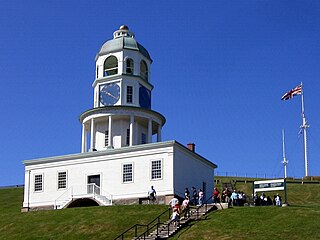William Joseph Weaver [1] (1759-1817) was an artist born in London who came to prominence in North America. His portrait of Alexander Hamilton hangs in the United States State Department, and his full-length portrait of Prince Edward, Duke of Kent and Strathearn, hangs in Province House (Nova Scotia), Canada. He also worked for Joseph Booth's Polygraphic Society.
Former Director and Chief Curator of the Munson-Williams-Proctor Arts Institute Paul Schweizer writes that Weaver's work "convey [s] a chaste elegance that is similar in look and mood to the finest neoclassical portraits made in North America." [2] Weaver's composition reflects a knowledge of British and French military portraiture. [3] He painted portraits and miniatures in many of the principal cities along the Atlantic seaboard from Halifax, Nova Scotia, to Savannah, Georgia. He also produced portraits of Martha and George Washington, though their locations are unknown. [4]
Weaver was one of the first professional artists to work in Halifax (c. 1797). He made portraits or miniatures of the city's merchants, aristocrats and military officers. Currently, six small portraits that Weaver painted in Nova Scotia have been identified. Five of these were painted on tinplate. There are likely more that are unsigned. [5]

General Sir William Fenwick Williams, 1st Baronet was a Nova Scotian military leader for the British during the Victorian era.
William Edward deGarthe (1907–1983) was a Finnish-born painter and sculptor who lived for much of his life in Peggy's Cove, Nova Scotia.

Province House in Halifax is where the Nova Scotia legislative assembly, known officially as the Nova Scotia House of Assembly, has met every year since 1819, making it the longest serving legislative building in Canada. The building is Canada's oldest house of government. Standing three storeys tall, the structure is considered one of the finest examples of Palladian architecture in North America.

Charles Fenerty, was a Canadian inventor who invented the wood pulp process for papermaking, which was first adapted into the production of newsprint. Fenerty was also a poet.

Fort Edward is a National Historic Site of Canada in Windsor, Nova Scotia, and was built during Father Le Loutre's War (1749-1755). The British built the fort to help prevent the Acadian Exodus from the region. The Fort is most famous for the role it played both in the Expulsion of the Acadians (1755) and in protecting Halifax, Nova Scotia from a land assault in the American Revolution. While much of Fort Edward has been destroyed, including the officers' quarters and barracks, the blockhouse that remains is the oldest extant in North America. A cairn was later added to the site.

St. Paul's Church is an evangelical Anglican church in downtown Halifax, Nova Scotia, within the Diocese of Nova Scotia and Prince Edward Island of the Anglican Church of Canada. It is located at the south end of the Grand Parade, an open square in downtown Halifax with Halifax City Hall at the northern end.

The Old Burying Ground is a historic cemetery in Halifax, Nova Scotia, Canada. It is located at the intersection of Barrington Street and Spring Garden Road in Downtown Halifax.

George Stracey Smyth was Commander-in-Chief, North America, Lieutenant Governor of Nova Scotia and Lieutenant Governor of New Brunswick.

The history of Nova Scotia covers a period from thousands of years ago to the present day. Prior to European colonization, the lands encompassing present-day Nova Scotia were inhabited by the Mi'kmaq people. During the first 150 years of European settlement, the region was claimed by France and a colony formed, primarily made up of Catholic Acadians and Mi'kmaq. This time period involved six wars in which the Mi'kmaq along with the French and some Acadians resisted the British invasion of the region: the French and First Nation Wars, Father Rale's War and Father Le Loutre's War. During Father Le Loutre's War, the capital was moved from Annapolis Royal, Nova Scotia, to the newly established Halifax, Nova Scotia (1749). The warfare ended with the Burying the Hatchet ceremony (1761). After the colonial wars, New England Planters and Foreign Protestants immigrated to Nova Scotia. After the American Revolution, Loyalists immigrated to the colony. During the nineteenth century, Nova Scotia became self-governing in 1848 and joined the Canadian Confederation in 1867.

Samuel George William Archibald was a lawyer, judge and political figure in Nova Scotia. He represented Halifax County from 1806 to 1836 and Colchester County from 1836 to 1841 in the Nova Scotia House of Assembly. He supported the Royal Acadian School.

Richard Bulkeley was an influential administrator in Nova Scotia from 1749 to 1800. Historian Phyllis Blakeley writes that Bulkeley, "assisted 13 governors and lieutenant governors from Cornwallis to Wentworth. In half a century of service he took part in the founding of Halifax, the immigration of New Englanders and loyalists, and the prosperity of the French revolutionary wars." During his lifetime, known for hosting dignitaries and grand parties, he was known as "the Father of the Province." When he died, he was the last surviving settler who arrived with Cornwallis.

Thomas Cochran or Cochrane was an Irish-born merchant and political figure in Nova Scotia. He represented Liverpool Township in the Nova Scotia House of Assembly from 1775 to 1785.

Harry Piers (1870–1940) was a Canadian historian. He was a long-serving and influential historian and curator at the Nova Scotia Museum in Halifax, Nova Scotia. Piers was born on February 12, 1870, in Halifax.

Robert Field (1769–1819) was a painter who was born in London and died in Kingston, Jamaica. According to art historian Daphne Foskett, author of A Dictionary of British Miniature Painters (1972), Field was "one of the best American miniaturists of his time." During Field's time in Nova Scotia at the beginning of the nineteenth century, he was the most professionally trained painter in present-day Canada. He worked in the conventional neo-classic portrait style of Henry Raeburn and Gilbert Stuart. His most famous works are two groups of miniatures of George Washington, commissioned by his wife Martha Washington.
The Royal Nova Scotia Volunteer Regiment, also known as the Loyal Regiment of Nova Scotia Volunteers and Loyal Nova Scotia Volunteers, from 1775-1780, the Royal Regiment of Nova Scotia Volunteers, from 1780-1783, and the Royal Nova Scotia Volunteer Regiment and Nova Scotia Volunteers, was a British Loyalist provincial battalion, of infantry, raised in 1775, to defend British interests, in the colony of Nova Scotia. The unit was commanded by Col. Francis Legge, until replaced by Col. John Parr in 1782. The Royal NS Volunteers never saw combat, but did play an important role in the defense of the colony of Nova Scotia, in the later years, of the American Revolution.

The Burying the Hatchet Ceremony happened in Nova Scotia on June 25, 1761 and was one of many such ceremonies where the Halifax Treaties were signed. The treaties ended a protracted period of warfare which had lasted more than 75 years and encompassed six wars between the Mi'kmaq people and the British. The Burying the Hatchet Ceremonies and the treaties that they commemorated created an enduring peace and a commitment to obey the rule of law.

The North British Society was founded in Halifax, Nova Scotia in 1768, the oldest Scottish heritage society outside Great Britain. North British is an adjective used as an alternative to "Scottish".

Formally known as "His Majesty's Council of Nova Scotia", the Nova Scotia Council (1720–1838) was the original British administrative, legislative and judicial body in Nova Scotia. The Nova Scotia Council was also known as the Annapolis Council and the Halifax Council. After 1749, when the judicial courts were established, the Nova Scotia Council was limited to administrative and legislative powers.
The Acadian Deputy was a position in 18th-century Nova Scotia, Canada, created by the Nova Scotia Council to represent the interests of an Acadian community to the Council.
The Royal Nova Scotia Historical Society is a historical society in Halifax, Nova Scotia that was founded in 1878 and is the second oldest in Canada The Society is a voluntary organization that operates without an office or paid staff. The Society first published the Nova Scotia Historical Quarterly and then the Nova Scotia Historical Review. Eventually the publication was named the Collections of the Royal Nova Scotia Historical Society and now it is known as the Journal of the Royal Nova Scotia Historical Society.
Endnotes
Sources